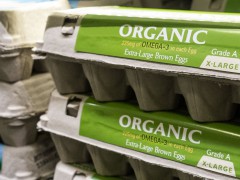I recently spoke on Legal Tools for Food Hubs at a conference put on by the Wallace Center’s National Good Food Network. (By the way, the conference was truly excellent, and I recommend that anyone working in food hubs, or local food generally, attend next year.) For those who don’t know, a “food hub” is a business that connects farmers to local markets by providing various services, such as aggregating products, marketing, and distribution. There are many legal tools that are potentially useful for food hubs or any food business. I focused my presentation on three issues of particular relevance to food hubs: (1) intellectual property; (2) contracts; and (3) business planning to minimize upcoming regulatory burdens associated with the Food Safety Modernization Act (FSMA). I thought I would share here some of what I told the group. Today’s post is about intellectual property. Later this week, I’ll cover contracts and FSMA issues.
Every business should have a strategy for identifying, protecting, and leveraging its intellectual property (IP). Food businesses are no different. Trade secrets, copyrights, and trademarks are valuable assets. But, if these assets are not carefully protected, they will be lost. The first step in protecting IP is to know what you have. An IP audit should be done and periodically updated to consider what IP the company has, what it is doing to protect that IP, and whether any steps should be taken to better protect the IP. The audit should consider the company’s patents or patentable inventions, copyrighted works, trade secrets or other confidential business information, and trademarks.
Each form of IP is acquired differently and protected differently under the law. For example, patent rights exist only if a patent is obtained from the government, but copyright is protected by law as soon as an “author” creates an original work in a fixed, tangible form. A trade secret is a property right in some piece of information or know-how — such as a proprietary recipe, formula, customer list, or pricing information — that gives the owner a competitive advantage precisely because it is not generally known. A trade secret is protected under the law only if it is kept secret. Thus, if a company with trade secrets does not take steps to maintain confidentiality, it loses the ability to protect those secrets legally, and competitors will be free to use the information. A trademark is a symbol, logo, words, or anything that distinguishes goods or services as coming from a particular source (i.e., the manufacturer or service provider). Trademark rights are derived from the use of a mark in connection with the sale of goods or services in commerce. A trademark owner who does not continue to use the mark, or who freely allows other people to use the mark or similar marks, will be deemed to have abandoned his or her rights.
Company policies and contracts are key to protecting and maintaining IP rights. For example, when a company hires a designer to create a website or marketing materials, the designer generally will be the owner of any copyright in the works created unless the company and the designer enter into a work-for-hire agreement or assignment of copyright to the company. Companies with valuable trade secrets should have internal policies in place to maintain confidentiality and nondisclosure agreements with employees and outsiders to whom trade secret information is disclosed. Whenever a company allows someone else to use its trademark, it should have a written license agreement controlling the use of the mark. Without such control, the trademark owner risks abandoning its rights.
Trademarks are especially important to “good food” businesses because the only way that a small, local, sustainable food company can compete in the marketplace is by distinguishing itself from conventional, industrial food. Even though the owner of a trademark has legal rights without registering the mark with the US Patent and Trademark Office, registration is a good idea. Without federal registration, a trademark owner’s rights extend only to the geographic area where the mark is used in commerce. That means that a trademark owner has no right to block a competitor in another state from using the same or a similar mark. In contrast, national registration on the Principal Register confers nationwide rights to block trademark infringement. Federal registration of a trademark provides other benefits as well, such as a presumption that the mark is valid and, after 5 years, “incontestability” status, which makes it much harder for anyone to attack the mark in court.
A particular challenge for local food businesses is to choose a brand name that can be protected under trademark law. A brand that includes the name of a geographic place (for example, “Pleasantville Food Hub”) is descriptive and, therefore, would not qualify for full trademark protection. Because trademarks are meant to distinguish the source of goods or services, the less distinctive the mark, the less likely it is to be protected. If a mark is descriptive, one option is to register it on the Supplemental Register. Although such registration does not confer the full set of rights that comes with registration on the Principal Register, it can deter others from using a similar mark and will block the registration of confusingly similar marks. Through continuous use and marketing, a descriptive mark can acquire so-called “secondary meaning” — that is, it comes to be associated with the owner of the mark such that it then can be registered on the Principal Register.
This is far from a comprehensive discussion of IP issues that may be relevant to food hubs or other food businesses. Feel free to contact us at info@foodlawfirm.com or (888) 908-4959 to discuss your business’s IP concerns.

















